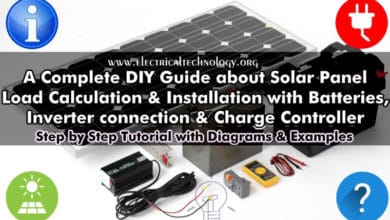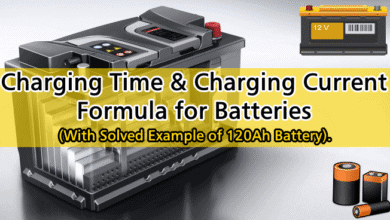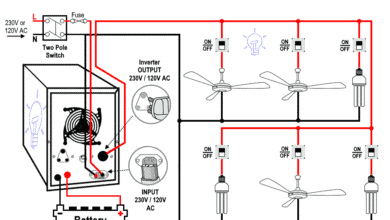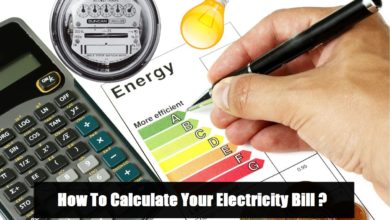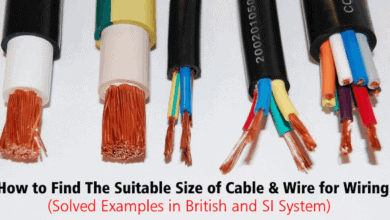How to Size Feeder Conductors with Overcurrent Protection
Sizing of Feeder Conductors with Protection Supplying from Main Panel to the Subpanel or Branch Circuits
Feeder Conductors
According to NEC 100 – Definitions, feeders are all circuit conductors between the service equipment (main panel), the source of a separately derived system, or other power supply source and the final branch-circuit overcurrent device (OPCD).
In simple terms, a feeder is the underground or overhead conductor that runs from the main panel to the subpanel (main lug) and associated load circuits in a dwelling or non-dwelling unit. The “starting point” of a feeder is the OCPD (breaker/fuse) in the main supply panel and “ending point” is the starting of branch circuit.
Click image or open in a new tab to enlarge
- Service Entrance Conductors → Runs between transformer on utility pole to the main panel in distribution system.
- Feeder Conductors → Runs between main panel to the subpanel (main lug). Feeder supplies power to a branch circuit overcurrent protection devices (OCPD).
- Branch Circuit Conductors → Runs between breaker in the main or subpanel to the final load point.
Related Post: How to Size Service-Entrance Conductors and Feeder Cables?
Feeder Conductors Sizing
Feeders are conductors between the main panel and subpanels or other major loads. Feeder conductors are used to carry electrical current from the main service equipment to subpanels, distribution panels, or branch circuits. They must be sized based on the calculated load demand and temperature rating. According to NEC 215.2(A), feeder conductors shall have an ampacity not less than the larger of 215.2(A) (1) or (A) (2) and shall comply with l 10.14(C).
Click image or open in a new tab to enlarge
Step 1: Calculate load demand in amperes (NEC 220.82 for residential, NEC 220.87 for commercial/industrial). The feeder load is the total electrical demand of all connected circuits. NEC 220.40 states that feeder conductors must be sized based on the calculated load, including demand factors and allowances. Refer to NEC 220.42–220.55 for general lighting, receptacles, appliances, and motor loads.
Step 2: Adjust for Continuous Loads (NEC 215.2(A)(1)): According to NEC 215.2(A)(1) and NEC 210.19(A)(1), feeders supplying continuous loads (e.g., lighting, HVAC) must be sized at 125% of the full load current. Continuous loads are those that run for three hours or more (e.g., water heater or commercial lighting). Feeder conductors must handle 125% of the continuous load + 100% of the non-continuous load.
Step 3: Consider Voltage Drop (NEC 215.2(A)(4)). NEC recommends a maximum voltage drop of 3% for feeders to ensure efficiency. If the voltage drop exceeds 3%, increase the conductor size. When distance involved (e.g. from the main panel to the subpanel), add 20% additional ampacity for every 100 feet to counter voltage drop in long-distance runs (over 50 feet or 15.25 meters) – NEC 310-16.
Step 4: Ambient temperature & derating factor. If more than three current-carrying conductors are run together, apply a derating factor from NEC Table 310.15(C)(1). If the ambient temperature exceeds 30°C (86°F), apply the correction factors from NEC Table 310.15(B)(1).
Step 5: Select proper conductor size from NEC Table 310.16. Feeder conductor size is determined using NEC Table 310.16 (formerly 310.15(B)(16)). The table provides ampacity ratings for different conductor sizes, insulation types, and temperature ratings. Based on the table data and ratings:
- Copper or Aluminum Material
- Temperature Rating (60°C, 75°C, 90°C)
- Environmental Conditions (Wet/Dry, Conduit Fill, etc.)
Example for THHN/THWN-2 Copper & Aluminum Conductors (75°C) based on NEC Table 310.16:
| Conductor Size (Cu) | Conductor Size (Al) | Ampacity at (75°C) |
| #8 AWG | #6 AWG | 50A |
| #6 AWG | #4 AWG | 65A |
| #4 AWG | #2 AWG | 85A |
| #3 AWG | #1 AWG | 100A |
| #2 AWG | #1/0 AWG | 115A |
| #1 AWG | #2/0 AWG | 130A |
Step 6: Select OCPD & EGC for feeder circuit. NEC 240.4(B) allows the next higher standard breaker size if the calculated ampacity does not match a standard breaker rating. Refer to NEC 240.6(A) for standard breaker sizes (e.g., 30A, 40A, 50A, 60A, etc.). For step by step guide, refer to the right size breaker selection guide. Similarly, use the EGC sizing guide based on 250.122 to use the proper grounding equipment conductor.
- Related Post: How to Size a Branch Circuit Conductors with Protection?
Example 1:
What is the suitable conductor size for a feeder supplying 100A to a Subpanel in a residential unit?
Solution:
The determined ampacity is 100A. Select conductor size from NEC Table 310.16 which is:
-
- Copper: #3 AWG
- Aluminum: #1 AWG
For ampacities of insulated conductors in raceway, cable, or earth (directly buried) the ampacities shall be specified in Table 310.16. In this case, #3 AWG copper or #1 AWG aluminum at (75°C) can be used based on NEC Table 310.16.
The grounding conductor (EGC) and grounding electrode conductor (GEC) shall be sized based on NEC Table 250.122 and 250.66 respectively which is #8 AWG Cu or #6 AWG Al.
Example 2
A feeder supplies a 90A continuous load at 240V, using copper THHN conductors in a raceway. What would be the suitable wire size for the feeder conductor?
Solution:
First of all, apply the 125% rule for continuous load:
Ifeeder = 1.25 × 90A = 112.5A
Now, select the conductor size using the NEC Table 310.16). Based on the table rating and data, the suitable wire size for 115-amp is #2 AWG Copper THHN.
Verify voltage drop when distance is involved. If the feeder is longer than 100 feet, check voltage drop. If excessive, increase to #1 AWG (130A).
Now, we are able to find the correct breaker size of OPCD device for the feeder designed to safely supply and maintain the load. In this case, the proper breaker size is 115A breaker (round up to the next standard size 125A, per NEC 240.6(A)).
For feeder conductors to a separate building, include an equipment grounding conductor (EGC) as per NEC 250.32(B) and table 250.122. Based on the table, the grounding conductor (EGC) is #6 AWG copper or #4 AWG aluminum or copper-clade aluminum.
Example 3:
A 60-amp subpanel is supplied by a 200-amp main panel. What is the required size for service entrance and feeder conductors?
Solution:
The step by step calculations are given in the previous article (See Example 2 for sizing feeder and service-entrance conductor).
NEC Table 310.12(A) applies only to service-entrance conductors used for a single-phase 120/240V 3-wire supply in a residential unit. It may also be used for underground service conductors and feeder conductors that serve as the main power feeder to a dwelling unit.
However, Table 310.12(A) should not be used for feeders running from the main panel to a subpanel due to the diversity factor, as these feeders carry only a portion of the total dwelling unit load. Instead, use NEC Table 310.16 for proper feeder conductor sizing.
Adjustment & Correction Factors
- Temperature Correction: If conductors are exposed to temperatures above 86°F (30°C), apply correction factors from NEC Table 310.15(B)(1)(1).
- Conduit Fill & Adjustment Factors: If multiple conductors share a conduit, apply NEC 310.15(C)(1) adjustment factors.
- Additional Considerations: Apply temperature correction, demand factors, and conduit fill adjustments when sizing feeder and service-entrance conductors.
Voltage Drop Considerations
- NEC recommends a maximum voltage drop of 3% for feeders and a total of 5% for service plus feeder to ensure efficiency.
- For long-distance runs (over 50 feet or 15.25 meters), increase ampacity by 20% for every 100 feet to compensate for voltage drop (NEC 310.16).
Resources:
- How to Size Equipment Grounding Conductor (EGC)?
- How to Size Grounding Electrode Conductor (GEC)?
- How to Find the Proper Size of Wire & Cable in Metric & Imperial Systems
- How to Find the Proper Size of Circuit Breaker?
- How to Size a Load Center, Panelboards and Distribution Board?
- How to Determine the Right Size Capacity of a Subpanel?
- What is the Correct Wire Size for 100A Breaker and Load?
- What is the Right Wire Size for a 4.8kW, 240V Range: #10 or #12?
- How to Determine the Number of Circuit Breakers in a Panel Board?
- How to Find Power, Voltage & Ampere Rating of Outlet, Receptacle and Plugs
- How to Size the Earth Conductor, Earthing Lead & Earth Electrodes?
- How to Size a Generator? Portable, Backup & Standby for Home & Commercial Applications
- How to Size and Find the Numbers of Ceiling Fan in a Room?
- How to Calculate the Number of Fluorescent Lamps in a Final Sub Circuit?
- How to Calculate the Number of Incandescent Lamps in a Final Sub Circuit?
- How to Size a Single Phase and Three Phase Transformer in kVA?
- How to Calculate the Battery Charging Time & Battery Charging Current ?
- How To Calculate Your Electricity Bill?
- How to Calculate the Floor Area For General Lighting?
- How to Determine the Number of Lighting Branch Circuits?
- How to Determine the Number of Branch Circuits? – 3 Ways
- How to Find the Number of Lights on a Single Circuit Breaker?
- How to Find the Number of Outlets on a Single Circuit Breaker?
- How to Determine the Suitable Size of Inverter for Home Appliances?
- How to Calculate the Right Size of Solar Charge Controller?
- How to Calculate the Right Size Battery?
- How to Size Panels, Batteries, Charge Controller and Inverter for Home
- How to Calculate the Number of Panels for a Load without Battery Backup?
- How to calculate the Cable size for LT & HT Motors?
- What is the Right Wire Size for 15A Breaker and Outlet?
- What is the Suitable Wire Size for 20A Breaker and Outlet?


